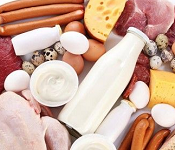
Safe Handling and Cooking of Meats, Milk and Eggs
Meat, milk and eggs and the staples of our lives, but to avoid food poisoning or foodborne illness, it's important to understand how to safely store, handle and cook them. In addition to the precautions below, be sure to see the page on proper cooking temperatures.
Basics
- KEEP IT CLEAN: Wash your hands and food preparation surfaces often, before and after handling meats.
- SEPARATE RAW FROM COOKED: Don't cross-contaminate! When handling raw meat, poultry, seafood and eggs, keep these foods and their juices away from ready-to-eat foods.
- COOK TO THE RIGHT TEMPERATURE: Cook to proper temperature. See the Minimum Cooking Temperatures chart for details on cooking meats, poultry, eggs, leftovers, and casseroles.
- REFRIDGERATE PROMPTLY: At room temperature, bacteria in food can double every 20 minutes. The more bacteria there are, the greater the chance you could become sick. So, refrigerate foods quickly because cold temperatures keep most harmful bacteria from multiplying.
FoodSafety.gov has pages for safety about each of the following meat, milk and eggs:
-
Meat
Raw meat may contain bacteria, such as E. coli, salmonella, and listeria, or parasites. It typically comes from the slaughterhouse, when the meat is cut up. Most contamination is on the poutser surfaces, but ground meats must be considered to be contaminated throughout (since the outer and inner sides are mixed). Thorough cooking destroys these harmful organisms, but meat can become contaminated again if it is not handled and stored in a cold fridge properly. -
Turkey
Turkey, like chicken is especially susceptible to salmonella and must be cooked to higher temperatures than, say, beef or fish. Turkeys should not have the cavity filled with stuffing, prepare this dish separately. And as soon as the turkey cools enough to handle, remove the meat from the bones and promptly refrigerate. -
Chicken and Other
Poultry
Poultry may contain harmful bacteria such as salmonella, listeria, and campylobacter. Washing chicken and other poultry does not remove bacteria., it is inside and throughout the meat. You can only kill these bacteria by cooking chicken to the proper temperature. -
Seafood
Like raw meat, raw seafood may contain bacteria that can be destroyed only by cooking. Some seafood, especially older, larger fish, like shark and tuna, may also contain toxins such as mercury which may be harmful for young children or an unborn baby. -
Milk, Cheese, and
Dairy Products
Raw milk, as well as cheeses made with raw milk, may contain E. coli, salmonella, and listeria. That's why it's important to make sure that milk has been pasteurized, which kills harmful bacteria WITHOUT harming the nutritional value - don't listen to the tin-foil hat crowd; the scientific studies - and the illness and fatalities from drinking raw milk - prove them wrong over and over. . -
Eggs and Egg Products
Fresh eggs must be handled carefully. FDA/UDSA rules require commercial eggs to be washed... but that also allows contamination to enter the egg as the egg naturally comes with its own protective coating. So, even eggs with clean, uncracked shells may occasionally contain salmonella. To prevent food poisoning, keep eggs refrigerated, cook eggs until yolks are firm, and cook foods containing eggs thoroughly.
